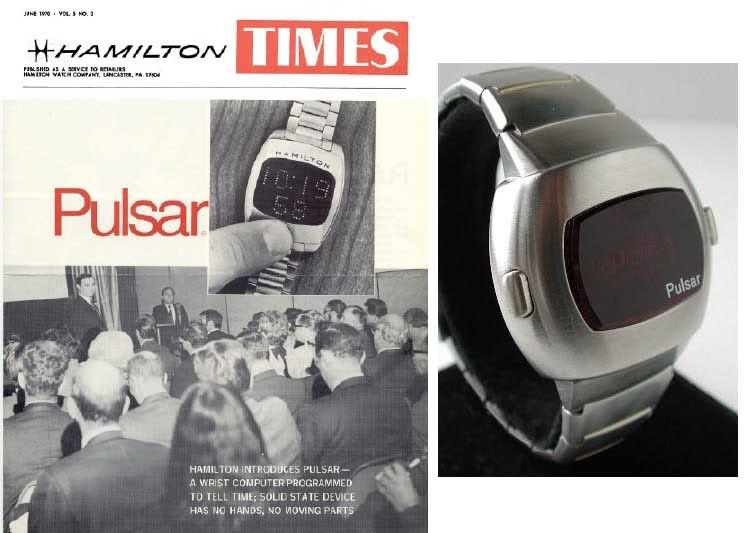
A Pulsar LED Digital Wrist Watch - One of the First Digital Watches Available
.
.
A Random Childhood Memory
.
Father Westhoff of Blessed Sacrament Church in Springfield, Illinois wore a gold Pulsar Red LED Wrist Watch.
It was the first, and only (to that point) Digital watch I had ever seen, and it would be many years until such watches would be common place.
Father Westhoff told us that it was given to him as a gift.
Father Westhoff would come out on the playground as he walked to the rectory where he lived, and children would rush over to him, and ask him to show them his incredible LED watch. It was quite a thrill.
.

The First Digital Watch I Ever Saw Was A Pulsar
.
As I recall to set the watch involved the use of small magnets.
All the children wanted to touch the watch, but he was very careful with it, saying that it was very expensive.
I knew that when I grew up I wanted such a watch, as it had something to do with the future, and with space, although I wasn't quite sure how, or why.
.

Father Westhoff Wore A Gold Pulsar Watch
.
..
Here's an excellent snippet from BBC on the history of the LED Watch:
Pulsar and the LED Display
In 1972, Hamilton produced the first watch with a digital display. They had hinted that they had a new breakthrough as early as 1970 but had two years of teething problems before its 18-carat gold Pulsar hit the world at a price of $2,100. By pressing a button on the side, the time was displayed on a red numeric display, caused by a light emitting diode (LED) display. Hamilton had provided a brief glimpse into the future in Stanley Kubrick's 1968 film 2001: A Space Odyssey when the company provided the futuristic digital clock that featured in the film. John Bergey who was head of Hamilton's Pulsar division said that this had inspired his team with the vision for their new timepiece which was then in development.
The LED is created by passing a electric charge through inorganic materials. Seven electronic switches went into making each of the numerals on the display. The original red light was generated by using aluminium gallium arsenide (AlGaAs), however Pulsar later produced a green LED using gallium nitride (GaN).
Many in the industry began to believe that the new quartz analogue watches would even be doomed to extinction so soon after their arrival that it wasn't worth buying into the trend, something which was reflected in the writings of Douglas Adams and other contemporary writers at the end of the 1970s and start of the 1980s.
Before the watch companies could 'do away with' the analogue watch though, they first had to bring down the price of the digital successor. Competition in the digital field increased and by 1975 there were over 80 varieties available. This competition helped to bring prices down but the product was still out of the range of the average consumer.
The Plastic Case
Texas Instruments brought the digital watch to the masses much as Henry Ford had brought the car. In 1975 they produced the first LED watch with a retail price of only $20; the following year this was halved. This level of competition saw Pulsar lose $6 million and find itself sold to competitors twice in the space of a year, eventually becoming a subsidiary of Seiko and reverting to making analogue quartz watches.
.Wow Father Westhoff wore a watch that cost enough to buy a car back then!
..
Recollections On Father Westhoff
Some might see that as a conflict - that somehow a Priest shouldn't be wearing a watch that was such a luxury, but it was a gift. Also Father Westhoff was such an activist for the poor and elderly that he was arrested several times while demonstrating at nursing homes if he found the conditions there unacceptable.
Father Westhoff was quite the radical back then in the late sixties, and early seventies. Eventually because of his advocacy for the poor, and elderly he was shipped out of Springfield (the state capital), and exiled to Decatur, Illinois.
Father Westhoff was the first priest I had the opportunity to admire for commitment to social issues, and Springfield, Illinois being a bastion of conservative politics forced his brand of social advocacy out. I'm sure the Bishop was worried about contributions more than he was whether elderly people were laying in their own excrement at the local nursing home.
Dave of the11thhour may want to share "The Slap Story", but despite this one incident Father Westhoff didn't seem to be anything but what a priest should be, which is increasingly rare in this jaded age.
I've read a New York Times article that detailed the reinvigoration of the Catholic Church. Millions of Hispanic immigrants are flocking not only to the United States, but also reversing the decline in attendance in parishes throughout the nation. In some cities there aren't enough Catholic churches.
It appears that the Church is once again grappling with the issue of how to approach social justice. In Latin America the Church has played a significant role as advocate for the impoverished masses, while in the United States priest, and Bishops have been expected to keep quite. This may change, and once again we may see the likes of a Father Westhoff here in our very own hamlet of conservativism. What a day that will be.

1 comment:
Westhoff was also a child molester. That is why he was shipped out of the diocese in the middle '80's and did not return until 2000.
Post a Comment